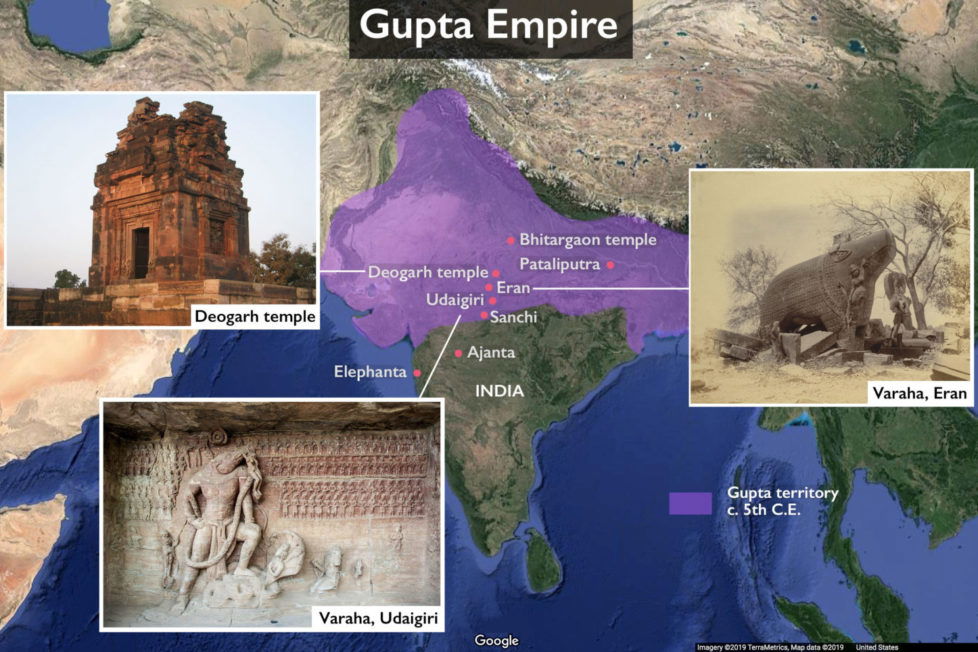The Guptas: The Rulers Who Brought India to Its Golden Age


The history of the Gupta period occupies a great place in ancient Indian history. The Gupta emperors provided political stability to northern India for 200 years. One after the other, worthy emperors spread their empire far and wide, uniting almost the whole of India. While Hindu religion progressed during the Gupta period, other religions also found a place. Let us explore why this era is called the Golden Age, and what made it so special.
The origin of this dynasty is believed to be from Chandragupta I, but it was fully expanded and developed by Samudragupta. Some writers called them Vaishyas, and some called them Kshatriyas. Samudragupta was crowned in 320 AD. Samudragupta’s brothers also revolted, but Samudragupta soon suppressed this rebellion. After Samudragupta, his son Ramagupta ascended the throne. Ramagupta was king for a very short time. Chandragupta II became king after Ramagupta and expanded the kingdom like Samudragupta.
Kumaragupta ascended the throne after Chandragupta II, and the last king of this era was Skandagupta. It is not that there were no kings after Skandagupta. After him, Purugupta and Budugupta ruled, but none of them could handle the state as well as Samudragupta. Gradually, the foundation of the state weakened. External invasions started, and internecine wars broke out, and the Gupta period gradually came to an end. The way Samudragupta handled the kingdom and expanded it, the later kings could not do it.
During the reign of Samudragupta, there was growth in every field, whether it is education, the field of art, or economic and social progress. Hindu religion and Hindu culture got maximum strength during this period. The most important feature of this period was that in this era, Sanskrit got the respect of the official language.
The kings of that time were considered to be the embodiment of religion. They were considered as the form of Vishnu on earth. There were many ministers and amatyas to assist the king. There were also some rules for the king, and if he did not follow those rules, he was removed from the throne. Among the big officers of the center, there were ministers, general commanders, and magistrates. The main source of income of the state was revenue. Full attention was paid to justice. The penal system was not harsh. The culprit was let off after taking a fine. If someone committed a heinous crime, then his right hand was cut off.
The duty of the king was not only to establish security, peace, and material progress of the state, but also to try for moral and spiritual progress. From the point of view of governance, the entire state was divided into provinces, which were called Bhukti or Bhog. The governance system was very strong during the reign of Samudragupta. Samudragupta had united the whole of India in one thread. All the states and kings were brought under his control. The states that were far away were returned to their rulers after being conquered, but tax was collected from them.
The subordinate kings had the right to rule voluntarily within their borders. This was the reason that when the Gupta emperors became weak, these dynasties succeeded in establishing their independent kingdoms. The foundation of a successful rule was laid by Samudragupta during his reign, that is why the rule of the Gupta emperors was highly successful. The firmness of the empire, peace, and progress of the citizens were proof of this.
The Gupta emperors were supporters of Hinduism. For this reason, special emphasis was placed on the superiority of Brahmins and the Hindu Chaturvarna system during this period. Before the Gupta period, many foreign invaders came and settled in India. These foreigners were given a place in Hindu society. There was progress in industry and trade, which led to the rise of the wealthy class. The Varna system was also emphasized during this period, but with great liberalism.
Anyone could change their religion. Shudras could do business. They could also join the army. Brahmins could also join the army. The Chhatriyas started trading and were also given the right to read the Vedas. The Shudras were told that if they remained virtuous, they had the right to perform Yagya as well. The most significant feature of the Gupta period was that the condition of the Shudras improved significantly.
When the varna system was not given much emphasis, the slavery system also became weak. When many foreign travelers from outside came to visit India, they could not even tell that slavery was prevalent. Slaves were not treated unfairly. Strict rules did not apply to anyone, yet the judicial system was very strong. Slaves were mostly made of people who were prisoners of war and debtors. The condition of the farmers also improved. Special emphasis was placed on agriculture. More rent was not collected from them. The wealthy class had built many dharamshalas for the poor and travelers.
Women were seen with respect. Women used to marry at an older age. If there was any religious or political event, then women used to participate equally in them. Monogamy was prevalent in this period. Only kings and rich people could keep more than one wife. No one had the right to abandon a woman. In this age, Ganikas, or prostitutes, were not seen with hatred. They were also called Devadasis. Devadasis started living in big temples. They were expected to master the art of dance and singing.
DISCLAIMER: The author is solely responsible for the views expressed in this article. The author carries the responsibility for citing and/or licensing of images utilized within the text.
